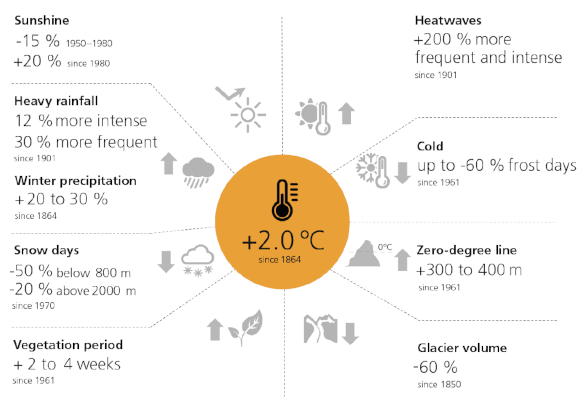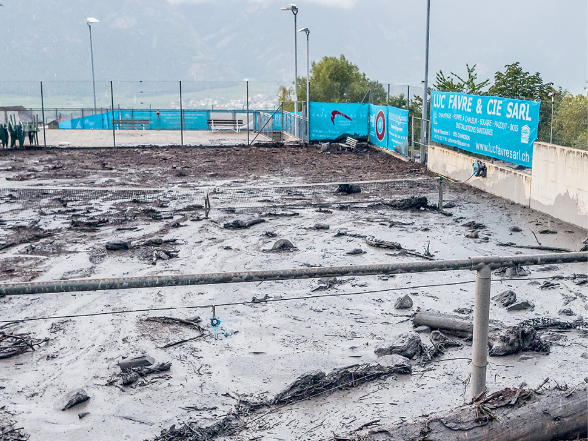Are extremes the new normal? In the alpine region, warming has increased about twice as much as the global average since the late 19th century. Switzerland is particularly affected by the impacts of climate change. This affects a wide variety of areas of society and natural and cultural areas in Switzerland. Observations show that climate change is already influencing the natural hazard situation. The Confederation is taking various measures.
Observed climate change in Switzerland

In the CH2018 Climate Change Scenarios changes observed so far in the most important climate indicators are summarized as follows:
Since 1864 the near-surface air temperature in Switzerland has increased by about 2 °C. As a result, the vegetation period is two to four weeks longer than in the 1960s and the zero-degree line has shifted upward by about 300 - 400 meters. Since 1970, the number of annual days of snowfall at 2,000 metres above sea level has diminished by 20 percent, and below 800 me tres above sea level, it only snows half as often as it did then.
In addition, the intensity of the highest single-day precipitation in a year has increased by around 10% on average and the frequency of heavy precipitation by around 26% over the last 100 years.
Since the beginning of the measurements, the annual and seasonal precipitation have not changed significantly. Only winter precipitation on the northern side of the Alps has increased by 20% over the last 100 years.
The Climate Scenarios CH2018 also describe how our climate could change up to the middle of this century and beyond.
Temperature: The highest temperatures in summer will increase more than the average summer temperature. By mid-century, the hottest day of the year could be +2 °C to +5.5 °C warmer than today, depending on the part of the country. With the maximum temperature, the number of very hot days will increase as well (≥ 30 °C). The zero-degree line could increase in elevation from today’s level at 850 metres to up to 1,500 meters above sea level by the middle of this century.
Heavy precipitation: In the future, heavy and extreme precipitation events will occur more frequently and intensively. It affects all seasons, but especially winter. In summer, individual precipitation events will become more intense despite decreasing rainfall. By the middle of the century, an increase in the intensity of the hundred-year precipitation by 10 to 20% is to be expected. Due to the rise of the snowline more precipitation will fall as rain rather than snow in winter, leading to a longer flood season (spring and autumn).
Rare, long-lasting weather conditions are responsible for large-scale floods. Due to the rare occurrence, no statistical analysis is possible so far and climate models do not provide consistent results regarding changes.
«In the course of global warming, the climate of many cities is shifting hundreds of kilometres south. Bern is taking a climatic journey to northern Italy / Milan.»
Jean-François Bastin, Researcher for Ecosystem Ecology at the Crowther Lab at ETH Zurich.
Important links
Impact of climate change on natural hazards
The risks from natural hazards in Switzerland are increasing primarily due to the increase in infrastructure values and settlement expansions in hazard areas. Due to climate change, however, more frequent and more intense extreme events are to be expected in the future. Natural hazards will increasingly occur in areas and at times of the year that have been spared from damaging events so far.

In brief, the following effects of climate change on natural hazards are expected:
Water
- Increase and intensification of short/intense precipitation events, with impact on local floods and surface runoff. Statements regarding trends in long-lasting precipitation are not yet available.
- Increase in erosion and sediment production, due to temperature increase and periglacial changes.
Landslide
- Changes mainly in the areas of vegetation cover and hydrogeology.
- Due to the increase in short/intense precipitation events, landslides and debris flows may occur more frequently.
Rockfall
- Changes especially in the areas of permafrost and frost change.
- Decrease in permafrost. Glacier retreat destabilises and leads to more fall events.
- Frost change occurs longer (temporally) and more frequently (spatially) and causes the increase of fall events.
Avalanche
- Changes mainly in the areas of the snow line, the amount of snow and the build-up of snow cover.
- With moderate climate change, there is hardly any impact on avalanche activity.
- Above 3500 m a.s.l. more snow is accumulated, thus larger wet snow avalanches are also possible.
- Increase in the range of avalanches (increase in regional spread).
- Below 2000 m a.s.l. decrease in snow volume = Decrease in avalanche frequency.
Natural hazards and climate change in Switzerland: State of knowledge (in german)
- Bericht Naturgefahren und Klimawandel in der Schweiz: Stand des Wissens (PDF, 2 MB, 09.06.2020)
- Zusammenfassung Naturgefahren und Klimawandel in der Schweiz: Stand des Wissens (PDF, 762 kB, 09.06.2020)
- Klimasensitivität Naturgefahren Teil 1: Methodenbericht (PDF, 3 MB, 16.04.2015)
- Klimasensitivität Naturgefahren Teil 2: Resultate (PDF, 4 MB, 18.03.2015)
- Klimasensitivität Naturgefahren Teil 3: GIS-Handbuch (PDF, 9 MB, 15.09.2021)
Federal measures for adaptation to climate change in the area of natural hazards
The learnings and insights from the events of the past decades form the basis for the current laws and the Strategy 2018 «Management of Risks from Natural Hazards» formulated by the National Platform for Natural Hazards PLANAT, which lists Switzerland’s adaptability as one of its four goals.
Adaptation to climate change in Switzerland - First part of the Federal Council’s strategy. Adopted on 2 March 2012

Goals, challenges and fields of action. First part of the Federal Council’s strategy. Adopted on 2 March 2012. 2012
The federal strategy „Adaptation to climate change in Switzerland" describes the following priorities for action in the area of natural hazards:
Increased risk of flooding
As a consequence of climate change there are likely to be more frequent incidents events of winter flooding due to the increase in total winter precipitation plus a rise in the snowline. Due to the expected intensification and accumulation of heavy precipitation, an increase in risk and greater damage from surface runoff must also be expected in the other seasons. In spring and early summer, the extensive snowmelt combined with intensive precipitation can exacerbate the situation.
Overall, the vulnerability of built-up areas, individual buildings, transport routes, infrastructures and agricultural areas will change and accentuate seasonally and regionally.
Decreasing slope stability and more frequent mass movements
In the high mountains, the stability of steep mountain flanks depends on the geological composition, slope inclination and ice conditions. Due to the melting of glaciers and the warming of permafrost, mass movements may increase depending on local conditions. Prominent examples of this are the devastating rockfall in 2017 on Pizzo Cengalo in the Bregaglia region of Graubünden and the large Moosfluh landslide in the Aletsch region, which involved more than 150 million cubic metres of rock mass. At lower altitudes, the risk of mass movements is increasing due to the rise in the snow line and the increase in heavy precipitation.

| Photo of the Trift glacier taken by the deformation camera in summer 2017 before the big ice avalanche on 10 September 2017. The unstable glacier area is in the centre of the photo. | Deformation analysis of 7 September 2017 (three days before the ice avalanche), calculated using special image analysis algorithms. Purple areas indicate large movements (approx. 40 cm/day) and light blue areas show very large movements (approx. 50 cm/day). |
The Swiss permafrost monitoring programme PERMOS investigates how permafrost deposits develop. The risk of landslides is also increased at lower altitudes by the rise in the snow line and the possible increase in heavy precipitation
Important links
Adaptation to climate change in Switzerland: Action plan 2020–2025

This publication does not exist in English. It is available in other languages.
In order to deal with these challenges in an even more targeted manner at the federal level, the second action plan «Adaptation to climate change in Switzerland: Action plan 2020–2025» was released in 2020. Priorities were identified for dealing with natural hazards in the future:
- Ensure monitoring of the hazard processes
- Knowing hazards and risks
- Design robust and adaptable protective measures
- Implement risk based spatial plannung measures
- Successfully manage natural hazard events
- Strengthen natural hazard awareness, higher education and research in the field of natural hazards
- Analyse significant events and the handling of risks from natural hazards
Protection against natural hazards is already comprehensively implemented in Switzerland. Depending on the situation, spatial planning, organizational, structural and biological measures are combined in the best possible way. Against the background of climate change, existing concepts and measures must be reviewed with regard to the changing hazard situation and adapted accordingly. Together with the cantons, the Confederation shall develop guidelines that further specify how to deal with climate change in hazard and risk assessment and in the planning of measures in order to jointly enable a transparent, systematic and process-specific approach.
Important links
- National Platform for Natural Hazards PLANAT: Management of Risks from Natural Hazards - Strategy 2018
- Adaptation to climate change in Switzerland: Action plan 2020–2025
- Adaptation to climate change in Switzerland
- Adaptation to climate change in Switzerland - First part of the Federal Council’s strategy. Adopted on 2 March 2012
Pilot programme
The climate will continue to change in the coming decades. We must adapt to new conditions. To enable this, the Confederation has been running the pilot programme "Adaptation to Climate Change" since 2013.
The second phase of the programme started in 2019 and comprises 50 projects on six topics. In the area of natural hazards, six projects are being implemented. More than 500 people from public and private organisations are involved in the implementation of the projects. The results of the various projects are largely available. In the course of 2022, the results of the projects will be published in a synthesis report.
Pilot programme Short films illustrate strategies for protection against natural hazards
Important links
Further information
Last modification 01.06.2022





